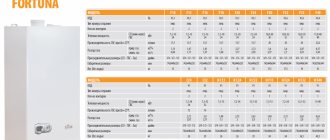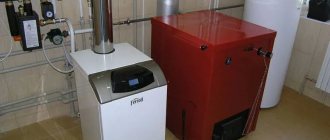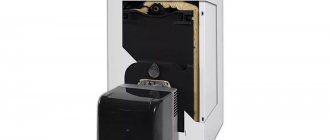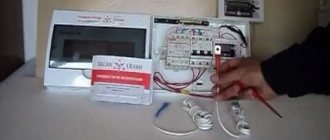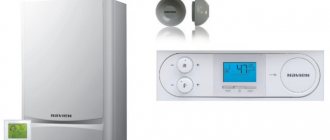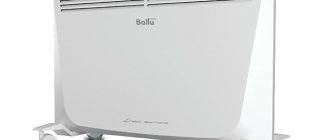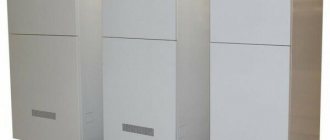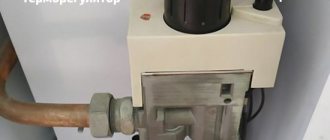Today is the time of high technology not only in IT, but also in the field of boiler equipment. An electric boiler with a pump is a new technical solution for autonomous heating in the Smart Home system to increase the efficiency of heat supply, create comfortable living conditions and safety during operation. This direction has many energy-saving connection options and the ability to integrate green energy elements into the circuit - wind generators and solar collectors. The feasibility of using an electric heating and hot water supply scheme will largely depend on the correct choice of equipment and its wiring, so the user needs to know all the pitfalls of this direction.
Main types of electric boilers for home
All models can be divided into three modifications, which differ in the heating element used. They are:
- heating elements,
- induction,
- electrode.
Although all of these types use electricity, the principle of their operation is different.
Electric boiler with heating element
These models are widely in demand among Russian consumers. They are simple and convenient, and their design reminds everyone of familiar devices - electric kettles or boilers. The advantages of the units lie precisely in their simple design. Among the disadvantages are a high rate of inertia and the need for a good temperature carrier.
Induction electric boiler for heating
In such equipment, the temperature of the coolant increases using an electromagnetic field. Units of this type boast wide advantages:
- high efficiency indicators of energy resource use;
- no need for frequent maintenance;
- incredibly long operating period;
- rapid heating of the liquid in the circulation line;
- precise adjustment of operating parameters.
The disadvantages are the large mass of devices and noticeable noise during operation. Another disadvantage of an induction electric boiler is the price. It is quite high compared to heating element models.
Electrode boilers for private homes
These aggregates are also called ionic. Household models of this type are equipped with electrodes between which current flows. As a result of this process, heat is released, which is used to heat the liquid. This operating principle determines various pros and cons of devices.
Positive aspects of the equipment:
- very compact dimensions;
- prompt access to operating temperature;
- high accuracy of heating parameters adjustment;
- complete safety of operation;
- nice price range.
Among the negative features, it should be noted that the maximum heating temperature is only 75 degrees. Also in this series is the inability to work with cast iron and steel batteries, greater capriciousness in operating conditions, special needs for grounding and the need to replace electrodes from time to time.
What does it mean to heat with air?
This kind of heating method has been known to ordinary people for a long time. Previously, ordinary houses were warmed by heated air, which from the stoves that were heated went through channels specially made for these purposes. And these days, many owners of country houses are thinking about how to make air heating for their homes with their own hands, since this heating method has many advantages over others.
To heat rooms, both internal and external air masses are used. If air is taken only from the street, then this kind of system will be called a supply air system. For this purpose, supply-type fans are used; they drive air directly to the heating unit.
The complete recirculation scheme looks like this: the internal air is in motion all the time, moving from a hot state to a cold state, after which it goes to the heating device, where it heats up again and moves into the room to release heat and a new cooling stage.
Air heating is a type of heating that you need to pay attention to if the choice is made first in order to save money. The most economical method is designed for the air to be heated in a heater or heat exchanger and distributed throughout the rooms through special channels
In each room, several holes can be placed near the floor, through which the air will fill the room with heat.
The most economical method is designed for the air to be heated in a heater or heat exchanger and distributed to rooms through special channels. In each room, several holes can be placed near the floor, through which the air will fill the room with heat.
Description of heating type
First, you need to stock up on three main ingredients.
- Heat generator. For this purpose, a heating boiler or furnace is most often chosen. The boiler will operate on any known type of fuel or be powered from the home electrical network.
- A network of air ducts that are usually made of galvanized steel. They may look unsightly, but are often decorated with all sorts of finishing materials to match the design of the room.
- Supply fan.
This heating design, equipped with your own hands, will heat any room well and fairly quickly. Climate control devices can be built into such a system, which in the summer will serve as air conditioning and air purification. The location of air conditioning devices is carried out both at the top of the room and at the bottom - this depends on the selected air heating scheme.
The supply fan forces warm air into the ducts. It is installed immediately under the combustion chamber of the boiler and, using a filter, cleans the air from all kinds of impurities and dust in order to supply it to the heating site - the heat exchanger. After it passes through the duct network, the cooled air is returned to the heat exchanger.
General features of electric boilers
Among the parameters common to all models, it is necessary to mention the implementation with one or two circuits. The first units can only heat buildings, while the second ones are also capable of preparing hot water for domestic needs.
All electrical devices up to 9.0 kW do not require permits and can operate from a 220 V network, however, their installation is not as simple as, for example, boilers. The fact is that such devices place a significant load on the electrical network. For this reason, special care must be taken to ensure the safe connection of equipment to the mains.
Operation of the devices is characterized by simplicity. Their adjustment is carried out using adjustment panels, which can be included in the kit or purchased separately.
Advantages
The popularity of electric boilers with a heating pump is explained by the following positive characteristics:
- Rich assortment
. Models of various capacities are available for sale, which makes it possible to acquire exactly the brand that best suits the operating conditions. In this way, you can choose a heating device for both a country house and an industrial premises: there are always options with suitable parameters in stock. - Economical
. Due to the high energy efficiency of modern electric heating boilers (their efficiency is close to 99%), their use allows you to save significant finances. An additional economic effect is facilitated by the use of a circulation pump, which is part of the structure itself. Having low energy consumption, it nevertheless significantly increases the rate of coolant passage through all pipes. As a result, rooms warm up many times faster. - Environmental friendliness
. Such a heating system does not emit combustion products during operation. Therefore, there is no need to spend money on organizing a chimney and providing additional air flow. For this reason, electric boilers are widely used in city apartments and office premises. It is important to remember that the absence of smoke does not mean that the ventilation in the house may be poor. - Ease of management
. This is facilitated by maximum optimization of monitoring and control devices. As a result, even an amateur can monitor the operation of heating equipment. Most of the models on the market are equipped with automatic control units: this allows you to resort to adjusting the operation of the system in very rare cases.
Equipment of this type is able not only to heat rooms, but also to cover the need for hot water. To optimize the water supply system, you will need to install an expansion boiler and a tank with a volume of 80 liters or more.
Calculation of power for the area of the house
We present a simplified calculation of power, since this issue is a topic for a separate article. Approximate calculation usually always gives results as close as possible to real needs.
If the electric boiler performs an auxiliary heating function in addition to the main gas or other unit, or fireplace, then for 120–150 m² a power of 3–6 kW will be sufficient.
Comparative table of average statistical electricity consumption by electric boilers
| Boiler power | Heating area, m² | Consumption, kW/hour | Boiler power | Heating area, m² | Consumption kW/hour |
| 3 kV 1 phase | 50 | 0.5–0.6 | 3 kV 1 phase | 30 | 1.5–1.8 |
| 5 kV 1 phase | 80 | 0.9–1.2 | 5 kV 1 phase | 50 | 2.0–2.5 |
| 9 kV 3-phase | 120 | 1.8–2.3 | 9 kV 3-phase | 90 | 3.6–4.2 |
| 25 kV 3-phase | 350 | 4.5–5.5 | 25 kV 3-phase | 240 | 9.5–11.0 |
If an energy-saving boiler is the main source of heat, then it is necessary to carry out calculations taking into account heat losses, which for an average private home with two-brick masonry and 2.7 m ceilings in the climate of the Moscow region is 1 kW/hour. It is recommended to select power with a margin of 10–20%, and for heating element heaters - by 20–30%, since their efficiency decreases due to scale. For 80 m² you will need an electric boiler of 9.6–10 kW (8 kW + 20%).
For SAV boilers, a power of 2.5 kW is 2100 kcal/hour, which is enough to heat 25–30 m². The calculation is affected by the required temperature. If you need to maintain 15–20 degrees in a room of 120 m², then a 6 kW unit will suffice.
An economical ion-type electric heating boiler with a power of 3 kW is suitable for heating 50 m². The same product with a heating element will heat 30 m².
Heating devices
If the installation of an electric boiler has virtually no effect on the efficiency of the heating system, then the same cannot be said about heating devices - heat transfer directly depends on the choice of these elements. The most effective design that works great in combination with electric boilers is underfloor heating.
Structurally, heated floors are tubular heat exchangers located under the floor covering or screed. During operation, they release energy to the entire floor surface, thereby ensuring uniform heat distribution.
Using heated floors provides several advantages:
- Warm floors are one of the most comfortable heating systems. The thing is that first of all, heat is transferred to the floor, so it becomes warm to the touch, and you can happily walk on it without shoes. With increasing altitude, the temperature decreases, due to which the most comfortable temperature regime for the human body is formed.
- The use of heated floors allows you to reduce the average temperature in the room. Classic convection heating assumes that to maintain a temperature of 20 degrees, you need to heat the air under the ceiling to 30 degrees. As a result, the average temperature will be about 25 degrees. In the case of heated floors, to maintain 20 degrees, you can warm the floor to 22 degrees. The temperature under the ceiling in this case will be about 18 degrees, and the average value will remain at the proper level. Due to this phenomenon, it is also possible to reduce heat loss, since the temperature difference in the house and outside decreases.
What to choose: comparison of consumption, cost, ease of use
If we focus on ease of installation, ease of operation, and average price, then the first place in the ranking is occupied by boilers with heating elements. As a standard, they are carried out in a monoblock case that is completely ready for operation after installation - it already has a safety group, an expansion tank, a circulation pump and other elements. You just need to connect it to the input and output of the heating system. But they are in last place in terms of economy and cannot be called energy-saving.
If we consider the question of which electric boiler is the most economical and with the best energy saving, then we should consider induction and ion units.
Vortex heaters are in first place in terms of economy, but they have a number of disadvantages that slightly offset this advantage: price, difficulty in repair, large dimensions. These are the most expensive and inconvenient electric boilers considered: the cost of such a 25 kW product is 86 thousand rubles. (A new heating element for 24 kW can be bought for 46 thousand).
Below is a table comparing different types of electric boilers. But the data in it should not be unconditionally trusted - manufacturers are trying to show their products in a favorable light. For example, in other sources, ion boilers are shown to be much more economical and efficient than heating element boilers.
| heating elementnew | Electrode | Induction | |
| Efficiency | 98 % | 94 % | 99 % |
| Loss of power after 12 months of use | 20 % | 15 % | 0 % |
| Maximum pressure | 3 atm | 3 atm | 6 atm |
| Heating temperature | Up to 90 degrees | Up to 85 degrees | Up to 115 degrees |
| Life time | 3–7 years | 10–12 years | 30–60 years |
| Probability of failure within 12 months | 15–20 % | 15–35 % | 0 % |
Another disadvantage of SAV and VIN is the large dimensions of the housing itself and the individual elements that include the control cabinet. A product with a tubular electric heater contains everything you need in a compact case, and an ion boiler generally resembles a thick water pipe. The weight of a 25 kW induction boiler is 80 kg, a heating element of the same power is 40 kg.
Vortex boilers are increasingly being chosen for private homes. Although such devices are the most energy-saving, they are more often used in places where induction heating is indispensable - in industrial, production environments, and chemical plants.
Economics of VIN use
| The name of a room | Heated area/volume | VIN model | power, kWt | Cost kW/h, rub. | Monthly payment, rub./month. | Payment for the heating period, rub. |
| 1 room apartment | 50 m² | VIN-3 | 3 | 2.0 | 1227.6 | 9147.6 |
| House | 100 m² | VIN-7 | 7 | 2.2 | 2864.4 | 21334.4 |
| Garage box | 450 m³ | VIN-10 | 10 | 3.2 | 5952 | 45888 |
| Hangar | 1000 m³ | VIN-20 | 20 | 3.2 | 11904 | 91776 |
Ion (electrode) boilers are the best choice in the economy class in all respects, especially in terms of cost, if you need an energy-saving heater for heating a private home. Their economy and efficiency may be somewhat lower than that of induction and heating elements products, but this is compensated by ease of maintenance and small size. An important fact in favor of ion boilers is the price - these are the cheapest energy-saving heaters for heating (4-5 thousand rubles).
Ion boilers are a good option as an additional heating source. If you use them as main devices, you can embed several of these cylinders for greater efficiency.
Description and principle of operation of electric heating boilers
Gas boilers are popular due to the low cost of fuel, but it is not always possible to connect them due to the labor-intensive procedure and the need for coordination with government agencies. Energy sources for solid fuel units are even cheaper, but there are many more disadvantages - they pollute, require the removal of combustion products, fuel loading, and storage space.
The listed disadvantages are absent in electric boilers, which are sometimes the only option for heating if there is no possibility of supplying gas. Moreover, electrical devices are considered not only as additional or emergency sources, but also as the main devices for the preparation of coolant. With them you don’t have to worry about ignition and other inconvenient issues associated with fuel combustion.
The most economical electric boiler should be chosen from energy-saving induction and electrode models. But we must take into account that in any case, its operation will cost approximately 2.5 times more than gas units, at best 1.5 times. Economy is considered here for situations where there are no other alternatives to electricity or if this type of energy is cheap (there are alternative sources - solar collectors, etc.).
How electric boilers work, device
The general principle of operation of electric boilers for heating: the coolant (water) circulates using a pump along the circuit of the heating system, through the boiler (internal chamber, flask, coil) and is heated there by heating elements, heat exchangers with electrodes, and induction coils.
The main parts of the electric boiler: housing with heaters, circulation pump, power supply, expansion tank, control and safety system (pressure gauge, check valve and for releasing excess pressure).
Economical electric boilers are required in the following conditions:
- if it is not possible to use gas;
- a unit that is easier to maintain than fuel-powered devices is required;
- preference is given to a cleaner energy source;
- An additional heater is required in case the main device is turned off.
Pipes
What kind of pipes can be used for installation of filling and connections to the boiler and heating devices?
Low operating temperatures and moderate operating pressure allow the use of all types of metal, high-temperature plastic and metal-plastic pipes. The only thing that needs to be mentioned separately is the use of polypropylene:
Pipes must be reinforced with aluminum foil. It will reduce the elongation of the pipeline when heating water in the circuit;
The use of polypropylene pipes without reinforcement for heating needs. The heated spills lengthened and went in waves.
On long straight sections of pipes, expansion joints are needed - U-shaped, ring or bellows. They will not allow the bottling or riser to bend when heating water in the pipes;
Ring and bellows expansion joints for polypropylene pipelines.
- Straight sections are fastened movably with sliding clamps;
- When pipes are laid hidden, gaps remain at the ends of the grooves. They will allow the pipe to lengthen without destroying the groove seal.
Types of devices based on the heating principle and their description
Below are the main types of boilers operating on the principle of energy conservation:
- Heating elements. They are equipped with a tubular-type heating element that heats the moving liquid.
- Induction. The principle of their operation is based on magnetic induction. In this case, the ferromagnetic alloy is heated inside the coolant.
- Electrode (ionic). Units of this type combine advanced developments with a high degree of efficiency. They heat water by passing an electric current through an electrolyte solution. Its molecules are converted into cations and anions. The result of this process is the release of a significant amount of thermal energy.
Single-circuit and double-circuit
An electric heating boiler can be one of two main types:
- Single-circuit. Designed for heating rooms by circulating liquid inside radiators and in a closed circuit.
- Dual-circuit. They can not only heat your home. but also provide it with hot water supply. They are compact and some can be placed on the wall.
Advantages and disadvantages
The advantages of different types of energy-saving boilers are approximately the same and are as follows:
- Very high efficiency - up to 99 percent.
- During operation of such a device, soot and ash are not released, and oxygen is not burned out of the air.
- The equipment operates completely autonomously.
- Easy installation, management and maintenance.
- Minimum noise level during operation.
- High level of safety due to automatic power supply shutdown when there is no liquid in the heat exchanger.
- Relatively low price level in comparison with gas heating equipment.
- There is no need to install a chimney or arrange a place to store coal or firewood.
The list of main disadvantages looks like this:
- Electric shock hazard.
- Special requirements for the quality of water used for heat exchange. In case of non-compliance, the equipment will not last long.
Features of operation of electrode boilers
Advantages:
- high efficiency indicators - at least 95% efficiency;
- good environmental friendliness;
- combination of high power with small overall dimensions;
- is not afraid of electrical voltage surges.
Flaws:
- the need to use alternating power supply;
- periodic monitoring of electrolyte conductivity;
- arrangement of reliable grounding;
- you need to install a pump to circulate water in the heating system;
- Electrodes need to be replaced every 2-4 years.
Features of electrode heating boilers Numerous reviews will help you choose the best models of electrode boilers for heating a private home.
The efficiency of such units is due to the excellent shock-absorbing system and the use of economical fuel. No maintenance required. Electrode equipment has a longer service life.
What are the recommended criteria for choosing?
Focus on the main parameters of the boiler:
- Power, i.e. heat output per unit of time. Different models vary from 3 kW to 70.
- Expansion tank volume.
- Pressure at the outlet of the circulation pump.
The capacity of the working part of the membrane expansion tank (the other is filled with air) should not be less than 4% of the volume of coolant in the heating system. It expands by this amount when heated. Thus, for a circuit containing 150 liters of working medium, a boiler with a tank of 150 x 0.04 = 6 liters is suitable.
The pump pressure must be sufficient to overcome the hydraulic resistance of pipes and radiators. The height of the coolant rise does not need to be taken into account, since the circuit is closed. Those. calculated using one formula, regardless of the number of floors:
P = L / 100, where
- P – required pressure, atm (bar);
- L – contour length, m.
Example. For a heating system with a length of 80 m, a pump with a flow of 80 / 100 = 0.86 atm will be required. (bar). For example, Wilo-Star-RS is suitable.
Deciding on the type of electric boiler
heating elements new
Construction of a standard heating element electric boiler.
The most common are models in which a heating element (tubular electric heater) or a combination of both – a block of heating elements – is used as a heating element. Models in the form of a flask with a low-power heating element barely exceed the diameter of the heating system line and cost from 3-4 thousand rubles. However, the most popular and successful models are those with a classic rectangular body, which are mini-boiler rooms. Already from the factory, they are usually equipped with all the necessary components of the heating system: an expansion tank, a safety valve, an automatic air vent, a circulation pump, a set of sensors and measuring instruments. It is enough to connect the supply and return lines to the boiler.
It is in heating electric boilers that modern automation is used, which allows you to regulate the temperature by degree, modulating the power of the heating element block. It is also worth paying attention to the possibility of finer settings, the presence of a room thermostat in the kit, the ability to connect external control, and the presence of a built-in programmer.
Perhaps the only significant drawback of heating electric boilers is the formation of scale on the heating elements themselves. This happens when hard, untreated water is used as a coolant. However, even if you do not use filters, water that is not replaced every season will only produce a slight sediment once, with virtually no effect on efficiency. Otherwise, after 3-6 heating seasons, the efficiency may drop to 90, 80 or even 70%. To heat water to the previous temperature through a layer of scale, the boiler will need more power and time.
A layer of scale due to the use of hard coolant.
In extreme cases, the cost of a block of heating elements is in the range of 1,000-3,000 rubles, and you can replace them yourself, without involving specialists. The resource of other components of heating element electric boilers is practically unlimited.
| Photo | Model | Description | price, rub. |
| EVAN EPO-18 | One of the simplest and most inexpensive models is a flask with heating elements. It is controlled by a remote control, of which there are two variations: with 1 power level (on/off) or 3 power levels. Capable of heating the coolant to 85°C, it is equipped only with overheating protection. It is good in terms of price-quality ratio, but is much inferior in functionality to more expensive models (stepped rather than smooth power adjustment, simple operating modes and lack of fine-tuning capabilities). | 14 600-21 000 | |
| Reco 15P | A domestic electric boiler, differing from the previous one by the presence of a circulation pump, a safety valve and an air vent. It has enormous functionality for this price category, a full range of protections and a programmer. However, power adjustment is still stepwise, and the appearance, quality of materials and workmanship are inferior to foreign analogues. Some owners complain about noisy operation. | 24 000-28 000 | |
| Protherm Scat RAY 18 KE /14 | One of the best heating element electric boilers with an expansion tank and circulation pump for heating a private home. Known for reliability and durability thanks to high-quality alloys and assembly. The heat exchanger is additionally thermally insulated, it is possible to connect external controls and heated floors. There is auto-diagnosis, overheating protection, frost prevention mode, safety valve, air vent, pump blocking protection. | 41 000-45 000 | |
| Vaillant eloBLOCK VE 18 | Model of the reference German manufacturer. It is distinguished by highly efficient automation, which allows for more economical energy consumption, high reliability and durability, build quality and modern design. It has an additional layer of thermal insulation and operates almost silently. However, it is advisable to connect through a stabilizer, since the automation is vulnerable to voltage surges. | 48 000-52 000 |
Electrode (ionic)
A visual principle of operation of an electrode heating boiler.
An electrode or a group of electrodes is used as a heating element in ion electric boilers. The principle of operation is to supply them with alternating current, due to which their polarity changes at a high frequency, water ions move to one electrode, then to the other and heat up as a result of friction. Low-power models use only one electrode located in the center, and a metal body is used as the second. More powerful models use blocks of 3 electrodes.
Although the efficiency of all modern electric boilers is 99% or more, electrode electric boilers, when compared with simple heating element models without expensive automation, are considered more economical. After all, scale does not accumulate on the electrodes and they do not lose their effectiveness even after 10 years. On the other hand, ionic models mostly have simple automation with a minimum of adjustments, usually in the form of a remote control. The boilers themselves are just a flask with small diameter electrodes. Despite its compact dimensions, all elements of the heating system such as an expansion tank, circulation pump, safety group, etc. will have to be purchased and installed separately.
Another serious disadvantage of electrode boilers is high grounding requirements, incompatibility with steel and cast iron radiators, and the need to use a special liquid - electrolyte - as a coolant.
| Photo | Model | Description | price, rub. |
| Galan Geyser 15 | The most famous, small and reliable ion electric boiler of domestic production. It is equipped with three types of automation: from the simplest to quite advanced with a GSM module. For normal operation, it is advisable to use the coolant recommended by the manufacturer. | 8 200-8 900 | |
| Beryl-15 Ion | The Latvian analogue is known abroad, but underestimated in our country. Automation adjusts the work by assessing the temperature of the coolant and other factors, using energy more economically. | 8 400-8 500 | |
| Galan Galax G352 15 | Designed according to the principle of standard heating element models in a monoblock housing: with a circulation pump, expansion tank, safety valve, air vent. However, for a price comparable to the average price segment of heating element boilers, it is much inferior to them in functionality, of which only three-stage power adjustment and a small display. | 30 000-34 000 |
Induction
Operating principle of induction electric boilers.
Induction water heating electric boilers use an induction coil, which, when voltage is applied to it, creates a magnetic field. A ferromagnetic core (metal pipe) is placed inside the coil, inside which the coolant flows. The magnetic field created by the voltage acts on the core through Foucault eddy currents, heating it. The core, in turn, transfers heat to the coolant. With such flow-through heating, scale does not form, and the coolant heats up 1.5-2 times faster; all boiler components have an almost unlimited resource.
However, the cost of induction boilers is 1.5-2 times higher. All necessary elements of the heating system, as is the case with most electrode boilers, must be purchased and installed separately. The listed advantages are justified only in the industrial sphere; in everyday life they are not significant, especially against the backdrop of the disadvantages and more advanced analogues. Therefore, installing an induction boiler in a private house can only be reasonable if you want to use antifreeze as a coolant. But today, new heating elements models are already beginning to appear, in which antifreeze is allowed.
| Photo | Model | Description | price, rub. |
| Alternative energy VIN 15 | Electric boiler type VIN (vortex induction heater). It is controlled from a remote control in the form of a small cabinet. The dimensions of the installation of 3 boilers of 15 kW are 720x500x300 mm, and the weight is 75 kg. Floor installation is recommended. | 49 000-55 000 |
Advantages and disadvantages
Based on experience in operating different types of boilers for individual heat supply, experts rightly believe that the most convenient to operate is an electric boiler with a circulation pump.
Advantages of connecting electric boilers with a pump:
- Full integration of pump operation with thermal circuit elements.
- Low specific indicators for own energy consumption for the implementation of the assigned tasks; they have virtually no effect on the overall heating costs.
- The highest efficiency among other heating sources up to 99%.
- 100% automation of technological processes.
- Environmentally friendly – no harmful emissions into the atmosphere.
- Low specific coefficients of material consumption, there is no need to install expensive equipment on the chimney, create draft in the boiler and organize air supply to the combustion chamber.
In fairness, it should be noted that the system has one very significant drawback - the high cost of electricity for heat generation technology. There are several options to reduce energy costs:
- Effective thermal insulation of a heating facility.
- The use of combined heat production with the inclusion of secondary energy sources in the scheme: solar, wind, water heat pumps.
- Transition to multi-tariff electricity metering with the inclusion in the heat supply scheme of a storage tank for heating water during the period of the preferential tariff.
Guidelines and what to consider when choosing an economical electric heating boiler
An economical electric boiler must have programmable operation, the ability to connect a rheostat for on/off. during periods of low tariffs or when a certain temperature is reached, as well as to regulate heating. At a minimum there should be at least a three-stage power switch.
The ideal option is if the device has smooth adjustment and factory economy modes. The product must be suitable for connection to room rheostats, which have many fine settings and respond to the air temperature in the room.
Single- and double-circuit electric boilers
If you need to provide hot water at the same time as heating, then choose double-circuit electric boilers. Moreover, the electricity consumption in such products is practically no different from single-circuit ones. DHW water is heated by washing the heat exchanger in the heating boiler circuit, without mixing with its coolant. Such heating does not require additional power, although for greater efficiency there are models with increased energy consumption.
Two-pipe heating circuit with electric boiler
A two-pipe heating circuit with an electric boiler has many advantages compared to a single-pipe one.
The most important advantage is the ease of balancing the circuit, due to the fact that the coolant temperature in the first and last radiator is practically the same. There is, of course, a difference of several degrees, which does not have much effect on the readings of the thermometer in the room. The essence of a two-pipe heating scheme with an electric boiler is that the forward and return flows are separated, while this is not the case in a single-pipe system. There are different installation methods, which differ somewhat in their operating principles. So, two-pipe heating schemes with an electric boiler are:
- incidental;
- dead-end.
Which heating scheme to choose in a particular case depends to a large extent on the layout of the room and the number of circuits. Despite some differences, there is no significant difference in characteristics; both options are good.
Passing
The associated heating scheme with an electric boiler works according to the following principle:
- an electric boiler for water heating heats the liquid and supplies it to the main line, which has outlets to the radiators;
- from the first radiator, in addition to the direct one, another return pipe is added;
- the coolant passes through the main line, part of it enters a branch to the radiator, from which the water exits into another pipe (return);
- The coolant moves further along the return line, parallel with the water in the supply pipe.
Thus, the hot water in the direct line and the liquid that has already given up some of the heat in the radiators do not intersect. After each subsequent radiator, the coolant enters the return line. A special feature of the heating system with an electric boiler (two-pipe circuit) and its characteristic feature is that the direction of supply and return flow coincide. When the supply reaches the last radiator, its further movement stops, and the return flows on. This is what creates the conditions for passing circulation.
This creates some difficulties. The door needs to be bypassed somehow. To avoid this scenario, you can:
- make holes with sleeves in the wall through which the pipes will pass;
- install pipes in the floor or walls.
It should be taken into account that when laying communications using a hidden method, special attention must be paid to the quality of pipe connections. Thus, the most used material for such purposes is cross-linked polyethylene.
We have already talked about the characteristics and advantages of polymer pipes for heating.
Dead end
Dead-end heating scheme for a private house with an electric boiler.
The associated and dead-end heating scheme for a private house with an electric boiler have one design difference, due to which the directions of movement of the coolant in the forward and return directions do not coincide. As we have already said, in a passing circuit their motion vectors coincide, but in a dead-end circuit, on the contrary, the fluids move in different directions. How does this happen in practice? There are still the same two pipes running in parallel. One by one, the coolant flows from the heater and enters the radiators through the pipes. And not all of it, but only some part; the rest continues to move on.
From each radiator, water flows through the second pipe into the return flow pipe, where the liquid begins to move towards the heater. It is not yet clear why the coolant changes its vector of motion, but everything is simple. He has no other options, since on the last radiator both pipes are simply blocked by plugs, everything is a dead end, there is no further road. It turns out that except for moving in the opposite direction, the water, which has given up part of its heat, has no other alternatives. In addition, this process is stimulated by an electric pump built into the electric boiler for a closed heating system or installed separately.
Let us repeat once again that you need to start from the location of the boiler room, the layout and area of the house. There are, of course, double-circuit electric boilers for heating, but they are so expensive and impractical that no one wants to buy them. Even if you want it, you need to try to find it.
TOP electric boilers for home heating
Boilers with power up to 6 kW
ZOTA Balance 6
Compact electric boiler with three-stage power control
Expert rating: 96/100
A simple and inexpensive electric boiler is suitable for heating rooms with an area of 60 square meters. m. Thermal power can be adjusted within 2-6 kW. The air temperature adjustment range is 5°C…35°C. The domestically assembled unit is easy to install and does not cause any difficulties in operation.
Specifications:
- power – 2-6 kW;
- control – mechanical;
- installation – wall;
- power levels – 3;
- voltage – single-phase/three-phase;
- coolant heating – 30-90°C;
- weight – 8 kg;
- circuit breaker current – 16A/32A depending on voltage;
- additionally – protection against overheating.
Users note the proper operation of the boiler, the ability to connect to one or three phases. The boiler body is thermally insulated, and it is possible to use non-freezing coolants.
However, the ZOTA Balance 6 model does not have weather-compensating regulation, a pressure gauge, an expansion tank, a circulation pump or a safety group. But the cost of the unit is low - about 6000-7000 rubles.
Advantages
- Affordability
- 3 power levels
- Connection to a single or three-phase network
- overheat protection
- Ease of Management
Flaws
- Noise when turning on and heating the heating element
EVAN EPO 6
Floor-standing electric boiler with remote control panel
Expert rating: 92/100
A budget modification among the Evan range of heating units. Suitable for installation in a house or cottage with an area of no more than 60 square meters. m. In terms of characteristics, the models of the “Epo” series are similar to the devices of the “Standard” line from the same manufacturer. The cost reduction is due to the absence of a housing that combines the control panel and the boiler.
The coolant temperature is set by a thermostat, smooth adjustment is provided, the range is 30-85°C. Evan Epo 6 boilers are equipped with Czech Backer heating elements made of stainless steel.
Specifications:
- power – 6 kW;
- control – electronic, there is a power indicator, remote control panel;
- installation – floor;
- smooth temperature control;
- voltage – 220 V;
- coolant heating – 30-85° C;
- weight – 7 kg;
- additionally - a self-resetting emergency sensor.
Customer reviews about using the boiler vary. Satisfied users note the simplicity of the device, ease of control, and the unit’s equipment with reliable protection against overheating. However, there are complaints about the ill-conceived nature of the portable remote control unit and the breakdown of individual working units.
Advantages
- Low cost
- Emergency self-resetting sensor protecting against overheating
- Power-on indication
- Remote control panel
Flaws
- 1 power level
- Complaints about quick relay breakdown, board failure
Boilers with a power of 9 kW
Protherm Skat 9 KR 13
Technological electric boiler with expansion tank and circulation pump
Expert rating: 94/100
Heating element boiler with a power of 9 kW. The unit is an expensive model, but it already has a pump and a 7-liter expansion tank. This is a luxury device with multi-stage performance adjustment from 1 to 9 kW and a full-fledged security system.
Specifications:
- power – 1-9 kW;
- control – electronic, provided with an informative display, thermometer, power indicator;
- installation – wall;
- 9 power levels;
- voltage – single- or three-phase network;
- heating the coolant 25-85°C;
- weight – 34 kg;
- additionally - prevention of coolant freezing, protection against overheating, pump blocking, air vent, safety valve.
Despite the high cost of Protherm Skat 9 is popular among buyers. The opinions of most users are positive, but there are also negative responses.
The boiler is well assembled, compact and has an attractive design. It is possible to connect a thermostat and remote control.
Advantages
- There is a pump and expansion tank
- 6 power levels
- Display and electronic control
- Auto diagnostic option
- Work in single- and three-phase networks
Flaws
- High price
- There is noise from work at night
- Isolated complaints about the breakdown of the heating element
ZOTA 9 Lux 9
Electric boiler with intelligent control system
Expert rating: 93/100
A model with a good range of options. Zota 9 Lux provides automatic temperature control, the ability to save individual settings, self-diagnosis of faults and audible alarm signaling.
The user can control the parameters of the heating system via the phone.
Specifications:
- unit power – 9 kW;
- control – electronic, display, power indicator;
- installation – wall;
- temperature adjustment automatically or manually;
- voltage – supply of single-phase, three-phase network;
- heating the coolant – up to 90° C;
- weight – 19 kg;
- additionally - fault diagnosis, overheating protection, indoor and outdoor air temperature sensor, chronothermostat.
Zota 9 Lux is equipped with a self-resetting emergency blocking - after the breakdown is eliminated, the boiler continues to operate according to previously set parameters.
Despite the variety of options provided by the developer, the model is not particularly popular. The boiler is expensive, and the package does not include an expansion tank or pump.
Advantages
- Self-diagnosis of faults
- Temperature sensor system
- Chronothermostat – work at night rate
- Emergency signaling
- Saving work settings
Flaws
- No circulation pump and expansion tank
- Risk of damage to the control unit due to power surges
- Complaints about the work of technical support
Installation nuances
Installation begins with choosing a location for the electric boiler room; when installing powerful units over 6 kW, a separate room without access by unauthorized persons and children is recommended. New heating elements of an industrial heating boiler can be installed in the kitchen. The EC is positioned so that there is free space around it for maintenance and repair. Minimum clearances:
- to the top floor of the room - 0.80 m;
- to the “0” mark in the case of a mounted type - at least 0.50 m;
- to the walls - 0.05 m;
- to pipes - more than 0.50 m;
- in front of the boiler front - more than 0.70 m.
The level of the housing is important - it must be strictly horizontal.
The installation of the boiler depends on the type of heating system - with natural circulation, the electric boiler is located at the lowest point, with forced circulation - in any convenient place. It is possible to install not one unit, but several; in this case, they are connected in parallel so that they work with the same load.
Installation algorithm:
- For a wall-mounted structure, first install the brackets that are supplied with the unit.
- After attaching them to the wall with dowels or anchors, the housing is hung.
- The floor-standing unit is installed on a flat dielectric stand.
- They tie the heating and hot water circuits.
- Install shut-off and control valves on the inlet and outlet pipes.
- Install the sump sensors, pressure gauges and thermometers according to the working diagram.
- Connect the unit to the electrical network. A corrugated flexible pipeline can be used as a cable channel.
- If power surges in the network are frequent, then the connection must be made through a stabilizer.
- Electrical protection is installed, the fuse power is selected higher than the highest current load of the boiler in operating condition, grounding is required when connecting. Ground a 3- or 5-wire cable.
- The neutral working wire N is connected to the neutral bus of the panel.
- The grounding PE wire is connected to its “Earth” bus.
- For the power line, use the VVG brand of cable with the number of cores 3 or 5, with sections corresponding to the power of the EC, usually the size is indicated in the product passport.
- The double-circuit boiler is connected through a three-way electric valve. Based on a signal from the thermostat, it directs the coolant flow to heat the DHW or heating circuit.
- After completing the installation work, the boiler is inspected and made sure that it is installed strictly horizontally and all communications are connected to it.
- The boiler is filled with water and a pressure test is performed under tap water to determine leaks in the connections and the serviceability of the shut-off and control valves.
- Check the operation of the electrical equipment of the boiler and the circulation pump built into the boiler.
- Test the performance of sensors and security automation.
Electric boilers with a pump are the most advanced heating method with the possibility of modern heating control from 0 to 100%. Using the Smart Home system, control can be performed online, outside the walls of the house. And although the pump itself consumes additional electricity for its operation, these costs are quickly recouped in terms of comfort, autonomy and safety of services. The most important thing is that this scheme has a great future, given that any secondary energy resources from green energy can be easily integrated into it, which is why this type of heat supply is gaining popularity all over the world.
Choosing a boiler: assessing the main parameters
When purchasing a heating unit for installing an electric heating system, it is worth taking into account the area of the home, the heat-saving characteristics of the materials from which the house is built, as well as the climatic characteristics of the region.
Basic selection options:
- power;
- connection type;
- equipment;
- performance adjustment method;
- control option.
Power. The main characteristic showing the heating intensity. To determine it, use special calculators, rely on the recommendations of boiler manufacturers, or calculate it yourself.
The calculation norm is for 1 cubic meter. m of room should account for about 40 W of device power. The value must be adjusted taking into account probable heat losses
To the resulting value add 100 W per window and 200 W per entrance door.
The climate zone should also be taken into account. Table coefficients by which you need to multiply the calculated figure:
- northern regions – 1.8-2;
- central zone – 1.2-1.4;
- southern area - 0.7-0.9.
When choosing an electric boiler for a cottage or private house, the final value should be multiplied by 1.5. A reserve of 50% is needed to cover heat costs through the ceiling and walls.
Connection type. Electric heaters are divided into single-phase, operating from 220 V, and three-phase - requiring a recharge of 380 V
This parameter depends on the boiler power. For devices up to 9 kW it is possible to connect to a single-phase network. High-power units require a 380 V network supply. A separate three-phase network will require permission.
Equipment. There are two options:
- basic equipment - purchase of one boiler, the remaining necessary components will have to be purchased separately;
- mini-boiler - a complete boiler.
The second option is preferable. Purchasing and installing all components separately will cost more than purchasing and commissioning a complete boiler.
Power control method. The ease of use of the device depends on this parameter. Stepwise and smooth adjustment is possible. The first option is used in boilers with several heating elements.
The downside of the technology is the limited choice of capacities. To more accurately regulate the temperature in the room, use valves and thermostats on radiators
Smooth power selection is preferable. Its advantages: obtaining a more comfortable microclimate, energy efficiency. In budget versions of low-power boilers, there may be no performance adjustment at all.
Control methods:
- Mechanical. Such boilers are affordable, but the accuracy of temperature control is insufficient. In addition, mechanical systems are loud - clicking sounds are heard when shifting. This option is suitable for boilers operated in non-residential premises.
- Electronic. The control system is more convenient and economical. The use of electronic thermostats and thermostats allows you to save up to 20% of electricity. The downside is the high cost.
It is worth paying attention to the features of the case. It is better to choose a closed type boiler so that children do not have access to electrical parts.
We also recommend reading the article about arranging a boiler room in a private house. For more details, follow the link.
Main process
Installing the unit
First you need to install an electric boiler indoors. As we have already said, the unit can be floor-mounted or wall-mounted. In the first case, the kit includes a special stand, on which the “landing” is performed.
In order to hang the boiler on the wall, you need to prepare anchors with dowels and a drill with a suitable drill bit. First, mark the wall using a tape measure and a marker. The holes must be placed perfectly level in a horizontal plane. Next, we drill out the marked places, drive dowels into them and screw in the anchors. After the anchor is firmly seated inside the wall, you can hang the electric boiler.
We draw your attention to the fact that the installation of the electric boiler must be carried out perfectly level in both horizontal and vertical planes. Any misalignment can affect the performance and service life of the equipment
We connect the electrical wiring
Since an electric water heater has more power, it is necessary to connect it not from an outlet, but directly from the mains. To do this, a separate line must be drawn from the distribution box in the room, going to the boiler connection point. It is better to use hidden cable routing, because... in this case, the line will be protected from mechanical damage and the appearance of the room will not deteriorate.
It should be noted that to power the boiler it is necessary to use a large cross-section cable that can withstand fairly high current loads. We talked about how to correctly calculate the cable cross-section in the corresponding article, which we strongly recommend that you read.
So we draw your attention to the fact that small-power water heaters (up to 7 kW) can be connected to a single-phase network, which is often found in Khrushchev-era buildings and old-style apartments. Well, the last nuance at this stage that you should know about is that electric boilers up to 3.5 kW can operate from an outlet, and not from a separate line from the distribution box. Low-power boilers are ideal for connection in an apartment, because in this case the electrical wiring is usually single-phase and rewiring the cable is not always a practical solution
We install protective equipment
When all the input wires are connected to the electric boiler, it will be necessary to additionally protect it with a circuit breaker and an RCD installed in the main panel. The purpose of the first device is to protect equipment from short circuits and wiring overloads. Connecting an electric boiler through an RCD will protect you from leakage currents.
It is also recommended to connect a voltage stabilizer, because even small surges can damage the unit. I don’t think it’s worth talking about the need to ground an electric boiler. The main requirement is that the ground wire runs directly from the bus to the equipment frame.
We are launching
When all wiring elements are connected, it is necessary to check all connection points. There should be no exposed contacts, as well as damaged insulation.
It is also necessary to check all couplings, taps and pipe joints. Only after a high-quality inspection of the heating system can you proceed to its start-up. First, we open the valves connected to the equipment, and then turn on the electric boiler.
Pay attention to the functionality of the temperature and pressure sensors. Nominal values are indicated in the instructions included with the kit.
In case of obvious deviations, it is better to call a specialist.
We also provide for your attention a clear example of installation work:
DIY video instructions for connecting an electric boiler
Features and advantages of electric heating boilers
The features of electric heating boilers are at the same time their advantages. Due to their compact size, these devices can be installed in any part of the house. Heating using such units is safe and economical (compared to devices running on other types of fuel). An electric heating boiler significantly reduces the cost of heating rooms.
Electric heating boilers consist of a heat exchanger, control cabinet and automation; Even a non-specialist can handle the installation of such a water heating unit. To operate such heating, no special knowledge or skills are also required: it is enough to connect the device to the network and carry out the simplest settings, and the automation will do the rest.
Electric boilers are relatively light in weight, so they can be placed on a wall or on the floor without special niches or platforms. In the production of electric heating boilers, only high-quality components are used; even if some part of the device fails, it can be quickly replaced.
Sources
- https://MirCli.ru/kotly-otopleniya/elektricheskie-kotly/
- https://ProFazu.ru/elektrooborudovanie/obogrev/ekonomichnyj-elektricheskij-kotel-dlya-otopleniya-chastnogo-doma.html
- https://expert-dacha.pro/otoplenie/kotly-ot/ehlektricheskie-kotly/energosberegayushhie.html
- https://GradusPlus.com/kotly/elektricheskie/elektrokotel-dlya-otopleniya-chastnogo-doma/
- https://sovet-ingenera.com/otoplenie/kotly/elektrokotel-dlya-otopleniya-chastnogo-doma.html
- https://www.mtk-gr.ru/katalog/elektricheskie-kotly
Installation procedure
Most often, installation activities are carried out by professional installers, because... this requires special permission. However, knowing the sequence of operations will not hurt: at a minimum, this will allow you to monitor the work being carried out, ensuring the correct implementation of each stage.
Installation sequence:
- The most difficult thing when connecting an electric heating installation is to provide it with the necessary power. If the existing wiring is able to support the power of the device, then no modification will be required. Otherwise, you have to lay an additional line.
- After the power supply issue is resolved, the meter, electrical panel and RCD (minimum 25 A) are installed.
- Boilers are wall-mounted and floor-mounted. Typically, all the necessary fasteners are included with the system. After the installation of the electric boiler is completed, it is connected to the meter with a cable of optimal cross-section.
- Temperature sensors are connected via separate wiring. Their task is to automatically regulate the switching on and off of heating elements.
- A separate plumbing cabinet is used to install the heat accumulator.
- Some models do not have a built-in circulation pump: in this case, it must be installed separately. This will require an additional wire to supply power to the pump motor.
To connect all the elements into a single system, you will need pipes (metal or metal-plastic). When performing a test run of the circuit, you need to carefully ensure that there are no coolant leaks anywhere. As can be seen from the description, the installation work is quite complex, so a preliminary study of this process will not be superfluous.

